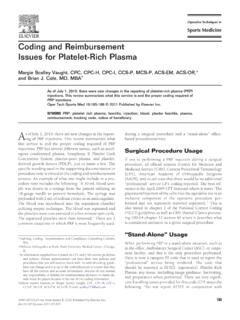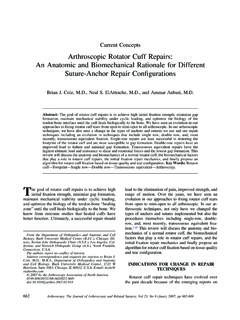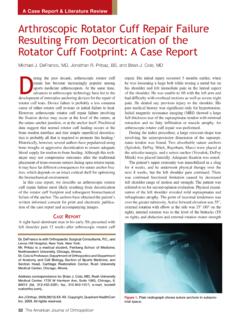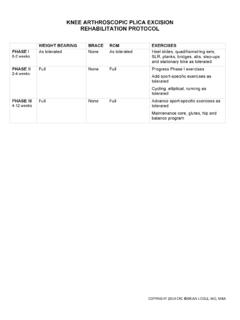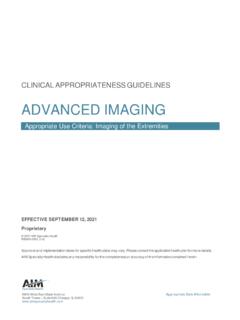Transcription of Coding and Reimbursement Issues for Platelet-Rich Plasma
1 Coding and ReimbursementIssues for Platelet-Rich PlasmaMargie Scalley Vaught, CPC, CPC-H, CPC-I, CCS-P, MCS-P, ACS-EM, ACS-OR,*and Brian J. Cole, MD, MBA As of July 1, 2010, there were new changes in the reporting of Platelet-Rich Plasma (PRP)injections. This review summarizes what this service is and the proper Coding required ofPRP Tech Sports Med 19:185-189 2011 Published by Elsevier , platelet rich Plasma , fasciitis , injection, blood, plantar fasciitis , Plasma , Reimbursement , tracking code, notice of beneficiaryAs of July 1, 2010, there are new changes in the report-ing of PRP injections.
2 This review summarizes whatthis service is and the proper Coding required of PRPinjections. PRP has several different names, such as autol-ogous conditioned Plasma , Symphony II platelet GraftConcentrate System, platelet -poor Plasma , and platelet -derived growth factors (PDGF), just to name a few. Thespecific wording used in the supporting documentation orprocedure note is critical to the Coding and reimbursementprocess. An example of what one might include in a pro-cedure note includes the following: A 10 mL blood sam-ple was drawn in a syringe from the patient utilizing an18-gauge needle to prevent hemolysis.
3 The syringe waspreloaded with 2 mL of sodium citrate as an blood was introduced into the separation chamberutilizing aseptic technique. The blood was separated andthe platelets were concentrated in a five-minute spin separated platelets were then removed. There are 2common situations in which PRP is most frequently used:during a surgical procedure and a stand-alone office-based Procedure UsageIf one is performing a PRP injection during a surgicalprocedure, all official sources (Center for Medicare andMedicaid Service [CMS], Current Procedural Terminology[CPT], American Academy of Orthopaedic Surgeons[AAOS], and so on) state that there would be no additional professional service CPT Coding reported.
4 The best ref-erence is the April 2009 CPT Assistant where it states Theplacement/injection of the cells into the operative site is aninclusive component of the operative procedure per-formed and not separately reported separately. This isalso stated in chapter 1 of the National Correct Coding (NCCI) guidelines as well as CMS Manual Claims process-ing 100-04 chapter 12 section 40 where it describes whatis considered inclusive in a given surgical procedure. Stand-Alone UsageWhen performing PRP in a stand-alone situation, such asin the office, Ambulatory Surgical Center (ASC), or outpa-tient facility, and this is the only procedure performed,there is now a category III code that is used to report the professional service being rendered.
5 The code thatshould be reported is 0232T: Injection(s), platelet RichPlasma, any tissue, including image guidance, harvesting,and preparation when performed. There are very signifi-cant bundling Issues provided for this code; CPT states thefollowing: Do not report 0232T in conjunction with*Auditing, Coding , Documentation and Compliance Consulting Chehalis,WA. Midwest Orthopedics at Rush, Rush University Medical Center, Chicago, information supplied here is based on CPT and CMS current guidelinesand policies. Private payers/carriers can have their own policies andprocedures that you will need to check with.
6 As with all Coding , guide-lines can change and it is up to the coder/physician to ensure that theyhave all the current and accurate information. Authors do not assumeany responsibility or liability for Reimbursement decisions or claims de-nials made by payers because of the use of this Coding reprint requests to Margie Scalley Vaught, CPC, CPC-H, CPC-I,CCS-P, MCS-P, ACS-EM, ACS-OR. front matter 2011 Published by Elsevier , 20551, 20926, 76942, 77002, 77012, 77021,86965. This is an all-inclusive code meaning no addi-tional reporting for the harvesting, spinning, inserting, orradiologic guidance.
7 Code 0232T covers it all. There havebeen references to different types of techniques used inproviding a PRP injection. One such technique is called peppering. Peppering has to do with placing the needlein multiple locations, and specific language includes thefollowing: recommend using a peppering techniquespreading in a clock-like manner to achieve a more expan-sive zone of delivery, needling in 5 different places attimes. This still falls under the 0232T if performed as astand-alone because there is now a code, it does not mean thatpayers/carriers will start to reimburse the service.
8 Many pay-ers/carriers still have their internal policies of means that the patient may have a financial responsibil-ity associated with the PRP injection. It is advised that thepatient is provided with a waiver similar to an AdvancedBeneficiary Notice (ABN), which Medicare has to alert a pa-tient and which requires the patient s signature to ensure thathe/she understands that he/she is responsible for the bill(ABN available at: ).Facility ReportingFacilities that wish to submit a claim for this procedureshould reference CMS Transmittal 1984, which provides in-formation related to facility reporting and Issues pertaining totheir ability to report IssuesMost payers/carriers have internal policies of noncoverage forPRP-type services.
9 A few examples are provided below, butproviders should reference their specific contracts with : this policy addresses the use of blood-derived growth factors, including recombinant PDGF sand PRP, as a primary treatment of wounds or othermusculoskeletal conditions, including but not limitedto the treatment of diabetic ulcers, ulcers related to ve-nous stasis, lateral epicondylitis (ie, tennis elbow), plan-tar fasciitis , or Dupuytren are frequently used as an adjunct to surgery,including but not limited to their use in periodontal,plastic/reconstructive, and orthopedic procedures;adjunctive use of PDGF is considered outside thescope of this policy.
10 This policy only discusses use ofblood-derived growth factors as a primary is distinguished from fibrin glues or sealants,which have been used for many years as a surgicaladjunct to promote local hemostasis at incision glue is created from platelet -poor Plasma andconsists primarily of fibrinogen. Commercial fibringlues are created from pooled homologous humandonors; Tissel (Baxter) and Hemaseal are examples ofcommercially available fibrin sealants. Autologous fi-brin sealants can be created from platelet -poorplasma. This policy does not address the use of : autologous blood-derived preparations (ie, PRP)are considered investigational as a primary procedurefor other miscellaneous conditions, including, butnot limited to, epicondylitis (ie, tennis elbow), plan-tar fasciitis , or Dupuytren contracture.

